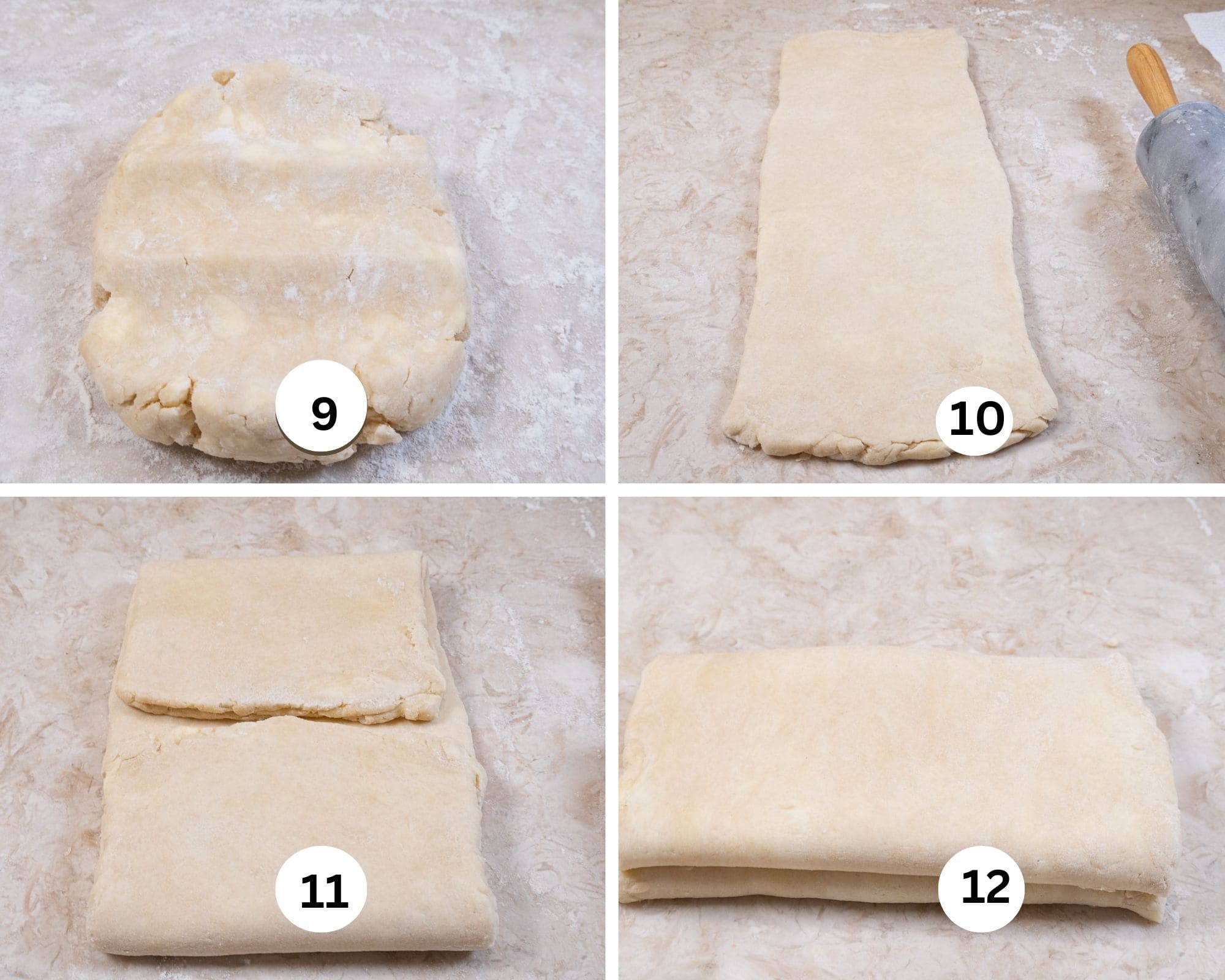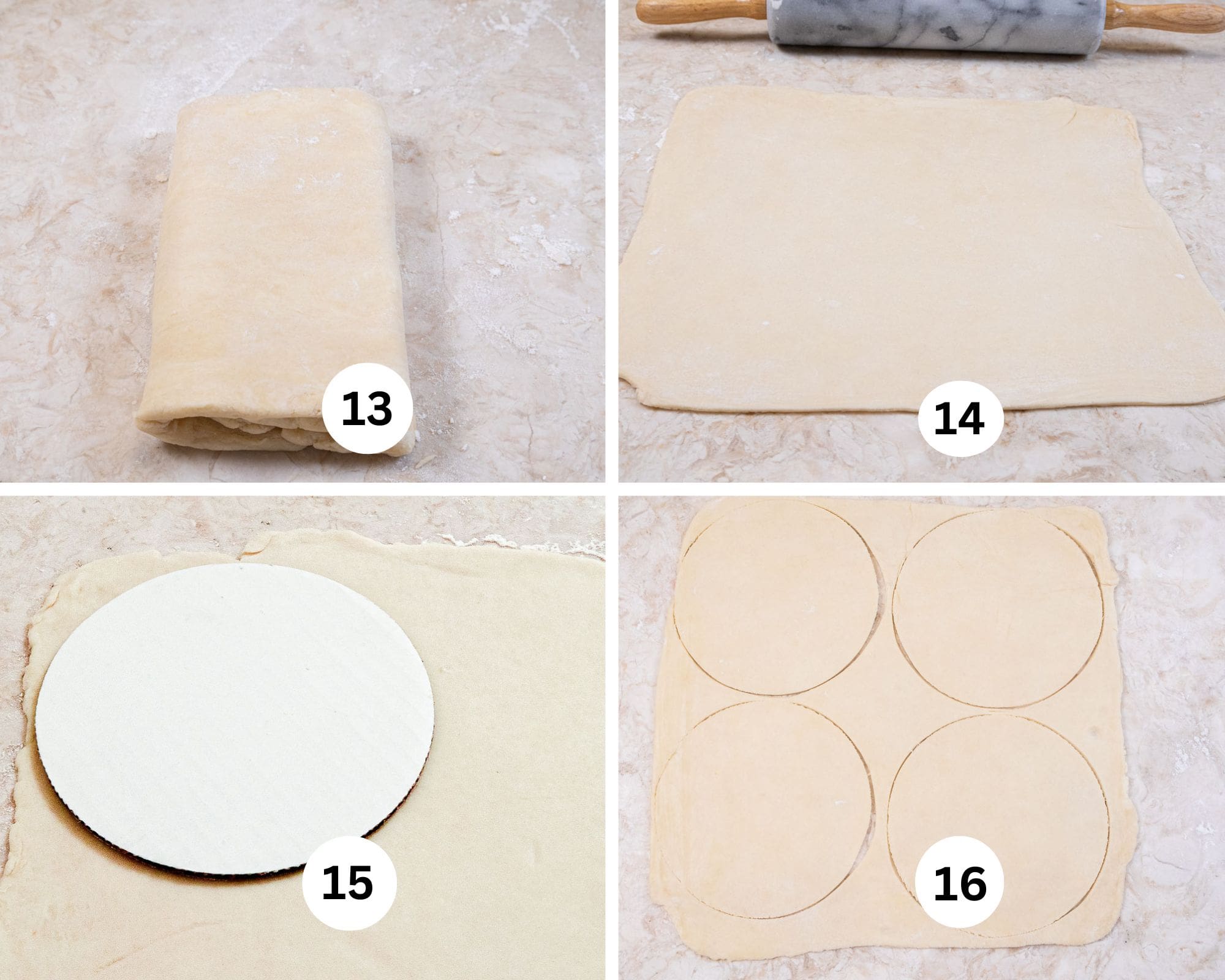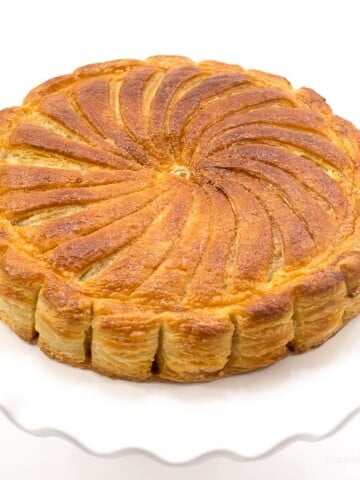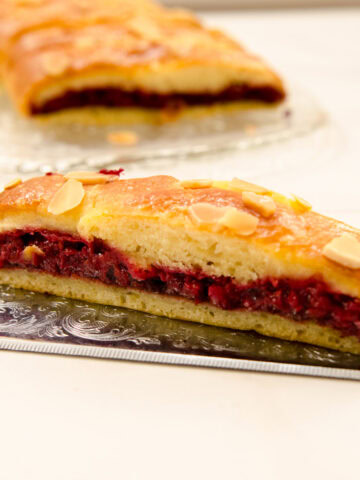This truly Amazing Pastry Dough Recipe featuring Fruit Filled Turnovers is a type of easy laminated dough made with sour cream that is a close relative to puff pastry requiring only two turns for a tender, flaky crust enclosing all sorts of goodies sweet and savory. In the past, this has been referred to as Mock Puff Pastry.

This pastry is not only easy it is flaky but more tender than normal puff pastry. I have filled mine with the easy but really flavorful prune filling from the Gateau Breton and the Solo Apricot Filling. I usually have a couple of different kinds of their pie and pastry fillings in my pantry as they are so much better than jams or preserves which can leak when heated. The Solo Fillings, which come in different flavors are bake-proof. In the professional world we know that means they will not leak when baked.
The Solo Fillings can be found on Amazon as well a grocery shelves. I haven't used all of them, but those I have I like with the exception of the Almond Filling.

Here are some other laminated pastries you might enjoy: Sunny Side Up Apricot Pastries, Pithiviers Made With Blitz Puff Pastry, Apple Caramel Hand Pies, Blitz Cronuts and Mille-Feuille (Napoleon Pastry). For a change of pace pastry that's super easy to make to to Easier "Danish Pastry Recipe.
Jump to:
What is Laminated Dough
Laminated dough (think puff pastry, croissant, cronuts, and kouign amann to name a few) consists of very thin layers of dough alternating with butter. The key with lamination is to keep everything really cold. Really cold butter, and sour cream in this case, water in others will keep the layers separated. In addition the butter needs to be in fairly large pieces before adding the sour cream so the butter pieces stay large. My post on Laminated Doughs has a wealth of information. American vs. European Butter is an indepth look at the differences between the two.
To achieve the desired multi layer of dough and butter, the dough is rolled out and then folded upon itself several times. Usually, the more folds, to a point, the more layers and the flakier the dough.
In the oven, the heat melts the layers of butter creating steam which then pushes the dough up to make the layers that define this type of pastry.
Laminated doughs made with water will be crisper than those made with sour cream but both will rise beautifully as long as the butter does not become one with the dough. If at any time it starts to soften when working with it, place it on a pan lined with parchment and refrigerate or freeze to firm.
This is a fast version that doesn't require butter blocks but still keeps the dough and butter separate. This Sour cream version is a joy to work with, rolls out easily and bakes to many layers as seen in the photo below with only two turns of the dough. Had another one or two been made, there would be even more layers.

Variations
There are so many ways to fill these turnovers. The Solo fillings are quick and easy but any of the many fillings used in the Marvelous Variable Kolache will work very well. Almost any filling will work as long as it is thick and bake proof. The turnovers are generously filled with ¼ cup each so jams or preserves won't work here. In addition to those, check out the Apple Carmel Handpies which use Werther caramels and a spiced apple filling.
Recipe Ingredients

FRONT ROW: Salt, baking powder
MIDDLE ROW: Unsalted butter
BACK ROW: Bread flour, sour cream
Key Ingredients
Unsalted Butter is called for and and I prefer regular American butter when making laminated doughs. This butter stays harder than the higher fat European butter which softens much faster when rolling out.
Bread Flour is used for its stregnth and crispness. All things being equal, I find it rises higher than all-purpose flour and produces a crisper, flakier pastry.
Salt enhances the taste of the baked pastry.
Sour cream sometimes has liquid in it. Make sure to pour that off and only use the firm part.
Fillings for Turnovers
- Prune Filling from Gateau Breton - 2 ½ times for 8 turnovers
- Pineapple Filling from Kolache - 2 times for 8 turnovers
- Apricot Filling from Kolache - 2 times for 8 turnovers
- Cream Cheese Filling from Kolache - 2 times for 8 turnovers (may have some left)
- Cherry Filling from Kolache - 3 times for 8 turnovers
- Fig Filling from Kolache - 2 times for 8 turnovers
- Solo Fillings - 2 cans for 8
Be sure to see the recipe card below for the exact ingredients & instructions.
Step by Step Instructions
If at any point the dough begins to soften, chill it in the refrigerator or freezer before moving on

Step 1. Cut the very cold butter in about 8 pieces per stick. If prepping the remainder of the recipe, refrigerate the butter. Step 2. Place the dry ingredients in the bowl of a mixer. Step 3. Add the cold butter. Step 4. With the mixer set on low, but the butter in leaving large pieces.

Step 5. Add the sour cream to the mixer. Step 6. Add 2 tablespoons of water and beat on low to form a large crumbly dough. Step 7. Pour the dough onto a work area. Step 8. Push it together to form a cohesive block of dough.

Step 9. To make rolling out easier, flatten the dough in about 3 or 4 places with the rolling pin. Step 10. Roll the dough out to about 16" x8". Step 11. Fold the top and bottom to the center, leaving about a ½" gap. Step 12. Fold the top down to make a neat package.

Step 13. Turn the pastry 90° with the open side to the right and repeat the rolling and folding above one more time. Step 14. Divide the dough in half (about 300 grams each). Roll one half into a 12 ½"x 12 ½" square. Step 15. Using a 6" circle cut 4 rounds out of the dough. Step 16. The cut rounds.

Step 17. Place a round of dough on the work table. Step 18. Fill with ¼ cup of the desired filling in the center of the dough about ¾" in from the edges. Wet the edges of the pastry with water. Step 19. Bring the top of the dough down to cover the filling and even with the bottom of the pastry. Step 20. Seal the turnover with the tines of a fork. Chill until cold throughout. When throughly cold, cut vents in the top of the dough and brush with egg wash as seen below.

Step 21. Roll the second half of the pastry into a 14 ½ x12 ½ inch rectangle. Trim to 14 x 12. Step 22. Divide the dough into four 7"x6" rectangles. Step 23. Place ¼ cup filling, just below the center of the pastry. Wet the edges with water. Step 24. Bring the top of the pastry down, making sure there is at least ½" without filling all around the four sides.

Step 25. Seal the seams with the tines of a fork and refrigerate until very cold throughout. Step 26. Remove from the fridge and brush with a beaten egg. Step 27. Cut 2 vents in the top of the turnover. Bake as directed. Step 28. After the turnovers are baked, the rise of the laminated dough can be seen.
Recipe FAQS
Because the top of the dough is turned over the filling.
Yes, either just as the pastry, well wrapped in foil and placed in a freezer bag for up to 3 months. Thaw in the refrigerator overnight to use.
This French laminated dough is also known as pâte feuilletée which means “dough of leaves”. This technique of laminated dough got its start in Vienna, possibly with a little help from the ancient pastries of Morocco.
Expert Tips
- Cold and clean are two of the most important points when making laminated doughs. If the butter softens at any time, refrigerate or freeze briefly to get it cold again. Make sure if any dough sticks to the rolling pin, to clean it off with a paper towel immediately. If you continue to roll, more pastry will stick to the pin and the pastry can tear.
- Refrigerate the filled pastries before cutting the vents on top and egg washing. This will make cleaner cuts for a better looking pastry. This should be done just before baking.
- The fillings are given for 8 pastries. Reduce the amount if using more than one filling.
- These keep well at room temperature, uncovered for a day or two.
- The pastry can be made in its entirety and frozen well wrapped for up to 3 months. Thaw in the fridge overnight to use.
- The completed pastries can also be frozen well wrapped for up to 3 months without the egg wash. Egg wash them just before baking. Either thaw them overnight and bake cold or bake them from the freezer adding additional time.

More Laminated Pastry Recipes you might enjoy
If you love this Amazing Pastry Dough Recipe, It would be hugely helpful and so appreciated it if you would take a moment to leave a rating below. Thank you.
Amazing Pastry Dough Recipe
Ingredients
Amazing Pastry Dough Recipe
- 1 cup unsalted butter (225 grams or 2 sticks)
- 1 ¾ cups bread flour (245 grams)
- ¾ teaspoon table salt
- ½ teaspoon baking powder
- ½ cup sour cream, cold (114 grams)
- 2 tablespoons water
- 1 large egg, well beaten
SEE THE POST FOR FILLINGS AND AMOUNTS
Instructions
Amazing Pastry Dough Recipe
- Cut the butter into about ¾" pieces. Keep in the refrigerator until needed. The butter needs to be very cold.
- Place the dry ingredients in the bowl of a mixer fitted with the paddle attachment. Mix briefly to combine.
- Add the chunks of cold butter. Mix on low to break the butter up but keep it in large pieces.
- Add the sour cream and mix to bring it together. Add the water and mix to form large crumbs.
- Pour the crumbs onto a work surface. Push the crumbs together to form a block of dough. Knead 3 or 4 times to smooth it out, keeping the butter in large pieces.
- Press a rolling pin into the dough about 3 or 4 times several inches apart from top to bottom. These "hills and valleys" will help roll out the dough more evenly,
- Sprinkle the surface lightly with flour. Roll the dough to about a 16" x 8" rectangle. If the pastry begins to soften, chill it until firm.
- Brush off any flour and fold the top and bottom to the center of the pastry, leaving a ½" channel.
- Fold the top over the bottom, creating a book like pastry. Turn the pastry 90° with the fold to the right.
- Lightly sprinkle the surface with flour and repeat the rolling and folding. Wrap in plastic wrap and chill until cold through out, overnight or up to 3 days.
For the half moon pastries
- With the pastry parallel to the edge of the surface divide the pastry in half (approximately 300 grams). Refrigerate ½ half of the pastry.
- Roll ½ of the pastry into a 12 ½" x 12 ½" square. With a 6" round guide (a saucer or cake round is fine) cut 4 rounds out of the pastry. Refrigerate. Repeat with the second half of the pastry. Chilling it also.
- Place one round in front of you and fill with ¼ cup of filling of your choice. Wet the edges of the pastry with water and bring the top over the filling matching the edges. Seal with a fork. Refrigerate. Repeat for the other 4 rounds.
- When ready to bake, preheat the oven to 375°F. Place 4 cold pastries on a parchment lined baking sheet and brush them with the beaten egg. Cut two vents in each pastry.
- It is best to bake one sheet at a time for about 20 to 25 minutes until medium brown. Refrigerate the second tray until baking.
- Serve lukewarm or room temperature. These reheat in the microwave for 20 seconds.
- Store at room temperature uncovered for a day or two. Do not cover or they will become soggy.
Rectanglar Turnovers
- Roll one half of the dough into a 12 ½" x 14 ½" rectangle. Trim to 12" x 14". cut the 12" side into 12" x 6" pieces. Cross cut to 7" x 6". You will have 4 pieces of pastry that are 7"x 6". Refrigerate.
- Place ¼ cup filling of your choice slightly below the middle of the pastry. Wet the edges and bring the top of the pastry down over the filling making sure there is about ½" without any filling round the 4 sides. Using the tines of a fork, seal the crust all the way around. Refrigerate.
- When ready to bake preheat the oven to 375°F. Place 4 pastries on two parchment lined baking sheets. Brush with the beaten egg and cut 2 vents in each pastry. Bake for 20 to 25 minutes until medium brown. It is best to bake one tray at a time. Refrigerate the second tray until bakiog.
- Cool to luke warm . Serve lukewarm or room temperature. These reheat in the microwave for 20 seconds.













Anthony says
The ingredients for the dough recipe call for 1 large egg but no mention of it in the instructions?
Helen S Fletcher says
Hi Anthony - The most important thing when getting ready to make any recipe is to read it from top to bottom and look at the Step by Step instructions. They show the steps and where everything goes in. The egg was mentioned 4 times. The first is in Step 26 of the pictures. Then in the recipe card there are 3 places. Step 4 in the half moon pastries instructions, Step 3 in the rectangular instructions and it is the last item in the Notes. Hope this helps.
Arlene says
This dough was a dream to work with. I followed the recipe exactly (bread flour and high-fat sour cream), and was rewarded by a light, flaky pastry. For those who might be intimidated by laminated doughs like puff pastry or croissant dough, I highly recommend you try this first. It will instil confidence when you see the layers puffing up in the oven.
Helen S Fletcher says
Thanks Arlene for the kind words and thank you for encouraging others. This is a really easy dough and I am happy to share it.
Carolyn zfowler says
Will diffently try this. Sounds great. Thanks for the recipe and photos.
Helen S Fletcher says
Thanks Carolyn.
Susan Kocsis says
Very well explained with details about instructions (like butter must be very cold) instead of saying something like "cold butter"
Gives clear emphasis on importance of detail
Helen S Fletcher says
Hi Susan, what a wonderful way to start the new year. Thank you for taking the time to comment. I come from a long line of teachers and my goal is to help making baking easier through words and photos. A big part of that is the photos as well as much description as I can give so the outcome is good for everybody. And, if you ever run into something you don't understand, please let me know. Happy New Year!
Pati says
Any idea if dairy-free products could be used for similar results?
Helen S Fletcher says
Hi Pati, I have no idea. If there is a dairy free sour cream, give it a try as long as it is thick like regular sour cream.
Nancy says
Could this same recipe be used to make a pie in a 9” pie pan?
Helen S Fletcher says
Hi Nancy - I haven't tried it and am not sure. If you try it let me know how it worked.
Linda says
Of course...It's pie dough. It will be great!
arturo Izquierdo says
Awesome. Easy to follow directions and great results
Thanks
Helen S Fletcher says
You're very welcome Arturo.
Trish says
Hi Helen,
This dough recipe looks fabulous and I'll definitely try it with the fillings you suggest. But, I'm wondering, if savory fillings will work too? If so, perhaps you have some suggestions.
Thank you!
Helen S Fletcher says
Hi Trish - I'm sure it will work with any savory hand pie recipe such as the Italian Calzone.
Diane Marie says
Can this recipe be used for a cheese danish? I have a recipe, but didn't care for the pastry. This one looks really good.
Helen S Fletcher says
Hi Diane, Danish dough is a laminated dough with yeast to give it a boost. I'm not sure but it's an interesting idea. If you try it please let me know. In the meantime I'll put it on my 2025 to do list. In the meantine see my post on Quick Danish -
Carol Darcy says
Your prep & instructions were very clear,concise and easy to follow
Helen S Fletcher says
Thanks Carol. I appreciate your kind words.
Carol Hartley says
In the description of the process, Step 24, there's a typo, reading "make sure there's 1/2" without pastry all round". It's corrected to " without filling" in the later recipe instructions. It would be good if they were the same.
Fern says
You told someone that they could use All-Purpose flour instead of bread flour. Could oat flour be used? I need to keep things low carb do to diabetes.
Helen S Fletcher says
Hi Fern - I have no idea about that since it's not a wheat flour and different flours act differently. Sorry to be of no help. I went online and found this. It may help. https://www.quakeroats.com/sites/quakeroats.com/themes/quakeroats/docs/quaker-oat-flour-101.pdf. If you try this please let me know how it worked.
Barbara Malewska says
Is it essential to use Bread Flour for this recipe? I just gave all of my bread flour to my grandson as I do not make bread at home - I have never been successful with that project and finally gave up!!! If is is essential, I will buy another bag.
Thank so very much for all of your wonderful recipes and helpful hints/information.
Regards, Barbara
Helen S Fletcher says
Hi Barbara, I love that your grandson bakes - so does mine. I think we are fortunate. Use All-Purpose flour if that is what you have. It will be fine. I would add 1 tablespoon water initially and then a half tablespoon and then the second half if needed. All purpose flour will absorb less liquid than bread flour.
Debbie says
what is the problem with the almond filling by Solo?
Helen S Fletcher says
It had a weird consistency and color and I didn't like the taste. It didn't taste of almonds. But everything else I've tried has been good.
SallyBR says
Cannot tell you how much I adore this post! will get to work soon!
Helen S Fletcher says
Let me know how it goes. You are such a great baker, I think you'll like this.